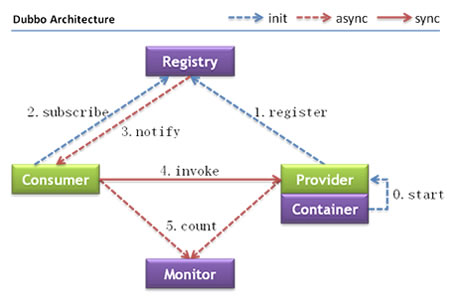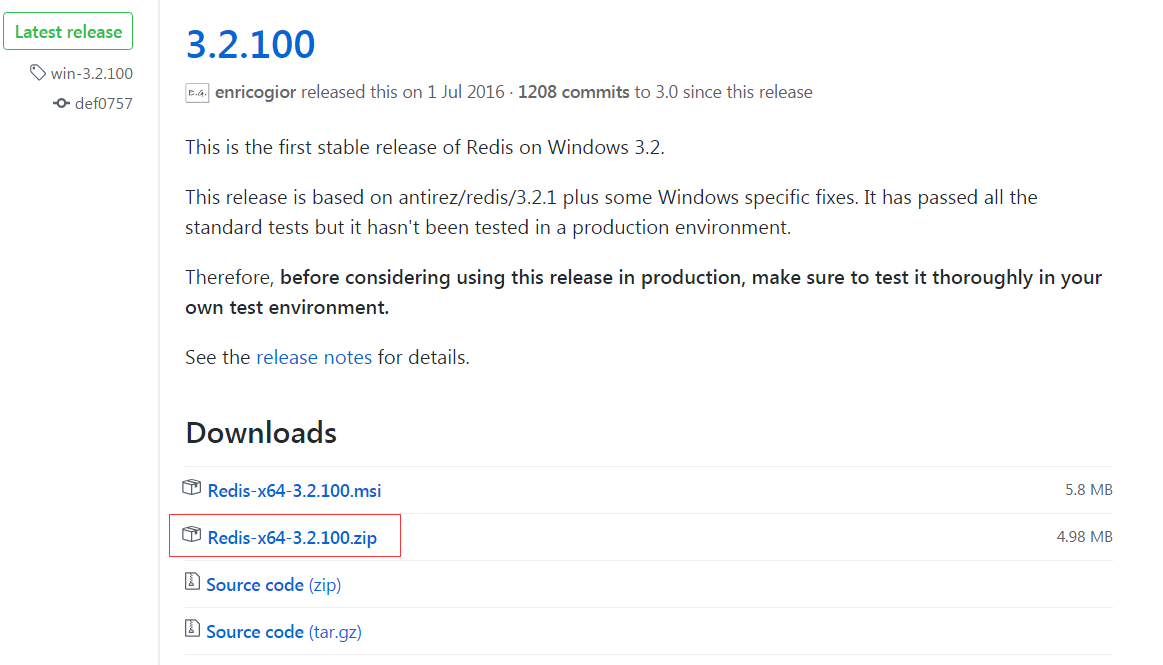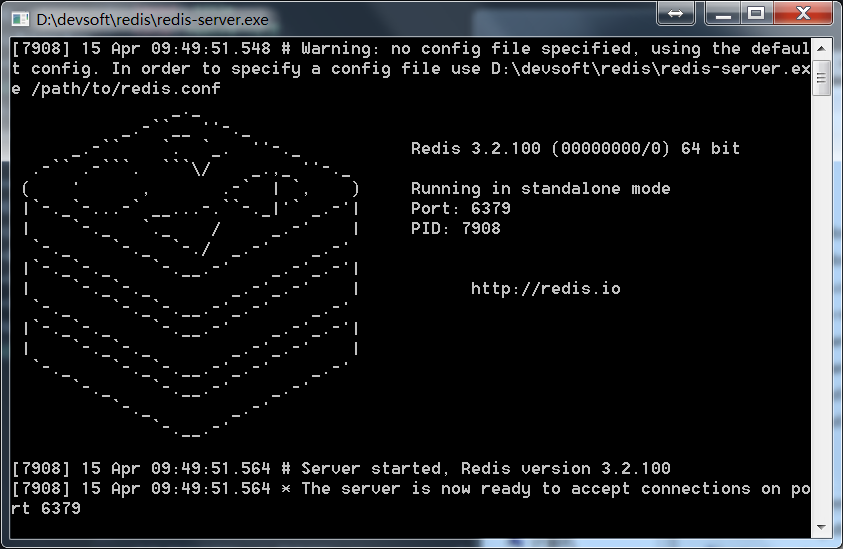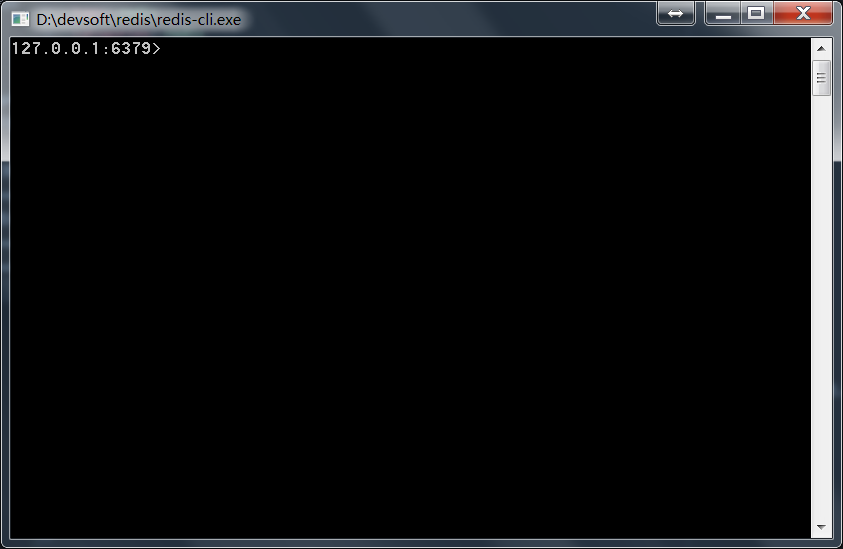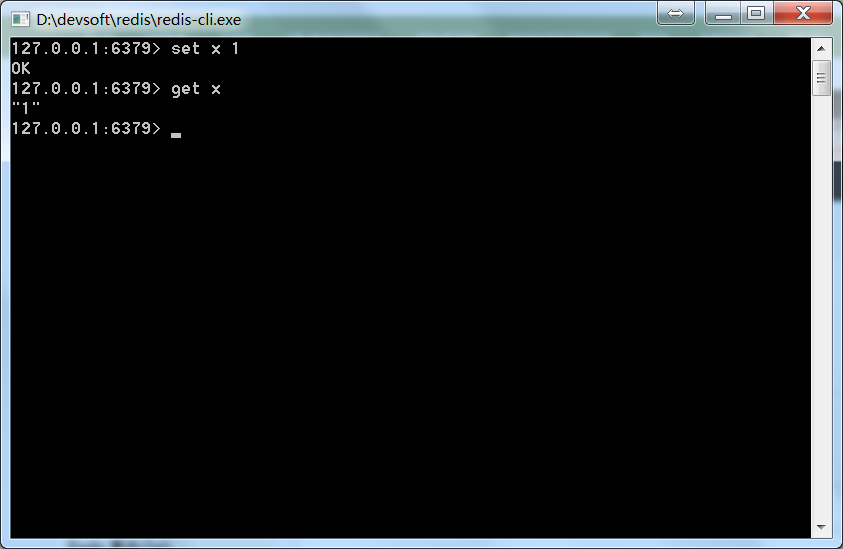zookeeper 简介
Zookeeper 分布式服务框架是 Apache Hadoop 的一个子项目,它主要是用来解决分布式应用中经常遇到的一些数据管理问题,如:统一命名服务、状态同步服务、集群管理、分布式应用配置项的管理等。
zookeeper 单机使用
访问http://zookeeper.apache.org/releases.html 并下载最新版本的ZooKeeper,这里我使用的版本是3.4.8。
下载完成后解压缩。进入conf目录,创建zoo.cfg配置文件(可复制已有的zoo_sample.cfg修改)。
说明一下几个配置项的意义(initLimit和syncLimit暂时先不管,后面有说明):
- tickTime:这个时间是作为 Zookeeper 服务器之间或客户端与服务器之间维持心跳的时间间隔,也就是每个 tickTime 时间就会发送一个心跳。
- dataDir:顾名思义就是 Zookeeper 保存数据的目录,默认情况下,Zookeeper 将写数据的日志文件也保存在这个目录里。
- clientPort:这个端口就是客户端连接 Zookeeper 服务器的端口,Zookeeper 会监听这个端口,接受客户端的访问请求。
保存配置文件,返回进入bin目录,双击zkService.cmd启动服务,控制台看到如下启动信息:
再双击zkCli.cmd启动客户端,控制台显示如下信息:
ZooKeeper客户端用于与ZooKeeper服务器进行交互,下面来进行简单的操作。
创建Znodes
创建具有给定路径的znode。
语法
示例:
使用参数可以指定创建的节点模式CreateMode,CreateMode有下面几种:
PERSISTENT:创建后只要不删就永久存在
EPHEMERAL:会话结束年结点自动被删除,EPHEMERAL结点不允许有子节点
SEQUENTIAL:节点名末尾会自动追加一个10位数的单调递增的序号,同一个节点的所有子节点序号是单调递增的
PERSISTENT_SEQUENTIAL:结合PERSISTENT和SEQUENTIAL
EPHEMERAL_SEQUENTIAL:结合EPHEMERAL和SEQUENTIAL
默认情况下,所有znode都是持久的。
创建Sequential znode,请添加-s标志,语法如下
示例:
创建Ephemeral Znode,请添加-e标志,语法如下
示例:
当客户端连接丢失时,临时znode将被删除。下面我们会通过退出ZooKeeper客户端,然后重新打开zkCli来验证。
获取数据
获取znode的数据,包括数据上次修改的时间,修改的位置等其他相关信息。
语法
示例:
访问Sequential znode,必须输入znode的完整路径,语法如下
示例:
这里我们来验证Ephemeral Znode。
先获取一次:
关闭zkCli命令行窗口,等待40s,重启客户端,再次尝试获取:
可以看到临时znode已经不存在了,而永久节点是存在的:
这里说一下,客户端连接断了之后,ZK不会马上移除临时数据,只有当SESSIONEXPIRED之后,才会把这个会话建立的临时数据移除。
而SESSIONEXPIRED是取决于客户端和服务端两方面的。
zk server端timeout参数:
- tickTime:zk的心跳间隔(heartbeat interval),也是session timeout基本单位,单位为微妙。
- minSessionTimeout: 最小超时时间,zk设置的默认值为2*tickTime。
- maxSessionTimeout:最大超时时间,zk设置的默认值为20*tickTime。
我们配置文件的tickTime为2000,所以这里服务端最大超时时间为20*2000ms = 40s。
zk client端timeout参数:这里cmd命令行不清楚怎么设置,但是应该也有默认的值,不过默认值也不知道= =!。
查看zookeeper源码可知,服务端拿到客户端的超时时间后,是会做一些判断的,客户端超时时间实际限制在{2*tickeTime, 20*tickTime}范围内。假设客户端设置了timeout为100s,实际40s就已经超时了;类似如果客户端设置timeout为1s,也要等到4s才超时。
回到我们的测试,建立临时节点,如果关闭客户端后立刻(4s内)连接上,临时节点仍然存在,而等待40s后session一定过期,临时节点就被删除了。
设置数据
设置指定znode的数据。
语法
示例:
查看结果:
设置监听
当指定的znode或znode的子数据更改时,watch会显示通知。
语法
示例:
设置了监听的节点被修改后,输出会稍微不同,带有watch信息
创建子节点
创建子节点类似于创建新的znode。唯一的区别是子节点znode的路径包含了父路径。
语法
示例:
查看子节点
查看znode所有的子节点。
语法
示例:
查看根目录下所有节点:
检查状态
查看指定znode的元数据。包含详细信息,如时间戳,版本号,ACL,数据长度和子节点znode。
语法
示例:
删除节点
删除指定的znode及其所有子节点。
语法
示例:
还有一种删除,只能删除没有子节点的节点,语法:
示例:
zookeeper 数据模型
简单使用了zookeeper之后,我们发现其数据模型有些像操作系统的文件结构,结构如下图所示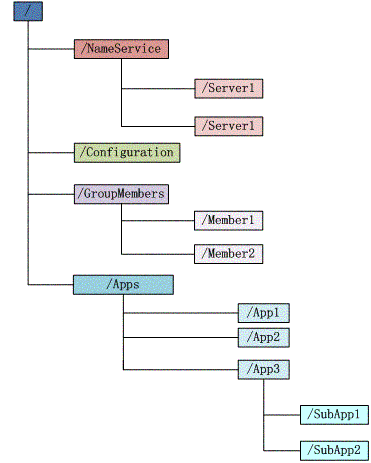
- 每个节点在zookeeper中叫做znode,并且其有一个唯一的路径标识,如/Server1节点的标识就为/NameService/Server1。
- znode可以有子znode,并且znode里可以存数据,但是EPHEMERAL类型的节点不能有子节点。
- znode中的数据可以有多个版本,比如某一个路径下存有多个数据版本,那么查询这个路径下的数据就需要带上版本。
- znode可以是临时节点,一旦创建这个znode的客户端与服务器失去联系,这个znode也将自动删除。zookeeper的客户端和服务器通信采用长连接方式,每个客户端和服务器通过心跳来保持连接,这个连接状态称为session,如果这个session失效,临时znode也就删除了。
- znode的目录名可以自动编号,如sznode0000000001已经存在,再创建sznode的话,将会自动命名为sznode0000000002。
- znode可以被监控,包括这个目录节点中存储的数据的修改,子节点目录的变化等,一旦变化可以通知设置监控的客户端,这个功能是zookeeper对于应用最重要的特性,通过这个特性可以实现的功能包括配置的集中管理,集群管理,分布式锁等等。
Zookeeper API
Znode是ZooKeeper核心组件,ZooKeeper API提供了方法来操纵znode。
客户端遵循以下步骤来与ZooKeeper进行清晰和干净的交互:
- 连接到ZooKeeper服务。ZooKeeper服务为客户端分配会话ID。
- 定期向服务器发送心跳。否则,ZooKeeper将设定会话ID过期,客户端需要重新连接。
- 只要会话ID处于活动状态,就可以获取/设置znode。
- 所有任务完成后,断开与ZooKeeper服务的连接。 如果客户端长时间不活动,则ZooKeeper服务将自动断开客户端。
示例:
结果:
zookeeper 集群
Zookeeper 不仅可以单机提供服务,同时也支持多机组成集群来提供服务。实际上 Zookeeper 还支持另外一种伪集群的方式,也就是可以在一台物理机上运行多个 Zookeeper 实例。
下面介绍伪集群模式的安装和配置:
- 新建一个总文件夹zookeeperCluster用于存放集群;
- zookeeperCluster文件夹下建立三个文件夹server1,server2,server3;
- 每个server里面新建一个data文件夹和一个log文件夹,并复制一份单机的zookeeper的文件夹;
- 每个server/data下新建一个myid文件并写入一个数字,server1就写1,server2写2,server3写3。Zookeeper 启动时会读取这个文件,拿到里面的数据与 zoo.cfg 里面的配置信息比较从而判断当前 server 到底是哪个 server。
进入各个server/zookeeper/conf目录,编辑zoo.cfg。由于是在一台机器上部署多个server,每个server要用不同的clientPort,比如server1是2181,server2是2182,server3是2183,dataDir和dataLogDir也要修改成相应路径。
123456789tickTime=2000initLimit=10syncLimit=4dataDir=D:/devsoft/zookeeperCluster/server1/datadataLogDir=D:/devsoft/zookeeperCluster/server1/logclientPort=2181server.1=127.0.0.1:2888:3888server.2=127.0.0.1:2889:3889server.3=127.0.0.1:2890:3890分别启动三个server/zookeeper/bin/zkServer.cmd。
说明一下集群的几个配置参数
- initLimit:这个配置项是用来配置 Zookeeper 接受客户端(这里所说的客户端不是用户连接 Zookeeper 服务器的客户端,而是 Zookeeper 服务器集群中连接到 Leader 的 Follower 服务器)初始化连接时最长能忍受多少个心跳时间间隔数。当已经超过 10 个心跳的时间(也就是 tickTime)长度后 Zookeeper 服务器还没有收到客户端的返回信息,那么表明这个客户端连接失败。总的时间长度就是 10*2000=20 秒。
- syncLimit:这个配置项标识 Leader 与 Follower 之间发送消息,请求和应答时间长度,最长不能超过多少个 tickTime 的时间长度,总的时间长度就是 4*2000=8 秒。
- server.A=B:C:D:其中 A 是一个数字,表示这个是第几号服务器;B 是这个服务器的 ip 地址;C 表示的是这个服务器与集群中的 Leader 服务器交换信息的端口;D 表示的是万一集群中的 Leader 服务器挂了,需要一个端口来重新进行选举,选出一个新的 Leader,而这个端口就是用来执行选举时服务器相互通信的端口。如果是伪集群的配置方式,由于 B 都是一样,所以不同的 Zookeeper 实例通信端口号不能一样,所以要给它们分配不同的端口号。
启动第一个server,这时会报大量错误。
没关系,因为现在集群只起了1台server,zookeeper服务器端起来会根据zoo.cfg的服务器列表发起选举leader的请求,因为连不上其他机器而报错。
我们再起第二个zookeeper服务,leader将会被选出,从而一致性服务开始可以使用,这是因为3台机器只要有2台可用就可以选出leader并且对外提供服务(2n+1台机器,可以容n台机器挂掉)。
再启动最后一个zookeeper服务。
开启一个客户端zkCli.cmd,可以看到成功连接集群中的master。
然后客户端就可以像之前单机一样进行各种操作。
ZooKeeper 典型的应用场景
Zookeeper 从设计模式角度来看,是一个基于观察者模式设计的分布式服务管理框架,它负责存储和管理大家都关心的数据,然后接受观察者的注册,一旦这些数据的状态发生变化,Zookeeper 就将负责通知已经在 Zookeeper 上注册的那些观察者做出相应的反应,从而实现集群中类似 Master/Slave 管理模式。
下面详细介绍这些典型的应用场景。
配置管理(Configuration Management)
配置的管理在分布式应用环境中很常见,例如同一个应用系统需要多台 PC Server 运行,但是它们运行的应用系统的某些配置项是相同的,如果要修改这些相同的配置项,那么就必须同时修改每台运行这个应用系统的 PC Server,这样非常麻烦而且容易出错。
像这样的配置信息完全可以交给 Zookeeper 来管理,将配置信息保存在 Zookeeper 的某个目录节点中,然后将所有需要修改的应用机器监控配置信息的状态,一旦配置信息发生变化,每台应用机器就会收到 Zookeeper 的通知,然后从 Zookeeper 获取新的配置信息应用到系统中。
比如将APP1的所有配置配置到/APP1 znode下,APP1所有机器一启动就对/APP1这个节点进行监控,并且实现回调方法Watcher,那么在zookeeper上/APP1 znode节点下数据发生变化的时候,每个机器都会收到通知,Watcher方法将会被执行,那么应用再取下数据即可。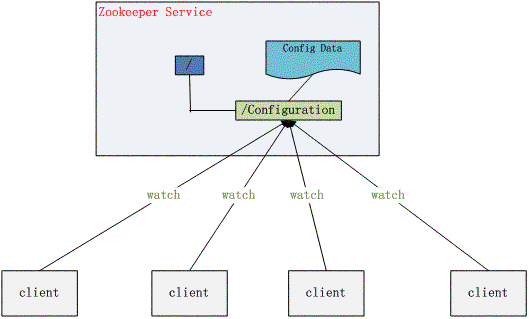
集群管理(Group Membership)
Zookeeper 能够很容易的实现集群管理的功能,如有多台 Server 组成一个服务集群,那么必须要一个“总管”知道当前集群中每台机器的服务状态,一旦有机器不能提供服务,集群中其它集群必须知道,从而做出调整重新分配服务策略。同样当增加集群的服务能力时,就会增加一台或多台 Server,同样也必须让“总管”知道。
Zookeeper 不仅能够帮你维护当前的集群中机器的服务状态,而且能够帮你选出一个“总管”,让这个总管来管理集群,这就是 Zookeeper 的另一个功能 Leader Election。
它们的实现方式都是在 Zookeeper 上创建一个 EPHEMERAL 类型的目录节点,然后每个 Server 在它们创建目录节点的父目录节点上调用 getChildren(String path, boolean watch) 方法并设置 watch 为 true,由于是 EPHEMERAL 目录节点,当创建它的 Server 死去,这个目录节点也随之被删除,所以 Children 将会变化,这时 getChildren上的 Watch 将会被调用,所以其它 Server 就知道已经有某台 Server 死去了。新增 Server 也是同样的原理。
Zookeeper 如何实现 Leader Election,也就是选出一个 Master Server。和前面的一样每台 Server 创建一个 EPHEMERAL 目录节点,不同的是它还是一个 SEQUENTIAL 目录节点,所以它是个 EPHEMERAL_SEQUENTIAL 目录节点。之所以它是 EPHEMERAL_SEQUENTIAL 目录节点,是因为我们可以给每台 Server 编号,我们可以选择当前是最小编号的 Server 为 Master,假如这个最小编号的 Server 死去,由于是 EPHEMERAL 节点,死去的 Server 对应的节点也被删除,所以当前的节点列表中又出现一个最小编号的节点,我们就选择这个节点为当前 Master。这样就实现了动态选择 Master,避免了传统意义上单 Master 容易出现单点故障的问题。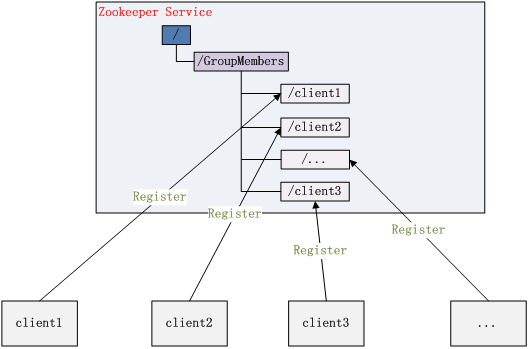
总结
通过命令行和API使用了zookeeper的基本功能。Zoopkeeper 提供了一套很好的分布式集群管理的机制,即基于层次型的目录树的数据结构,并对树中的节点进行有效管理,从而可以设计出多种多样的分布式的数据管理模型。
参考链接:http://www.w3cschool.cn/zookeeper/
http://www.blogjava.net/BucketLi/archive/2010/12/21/341268.html
https://www.ibm.com/developerworks/cn/opensource/os-cn-zookeeper/
